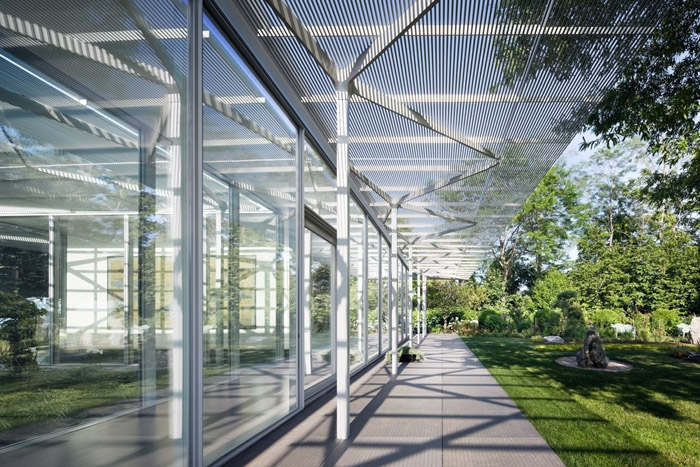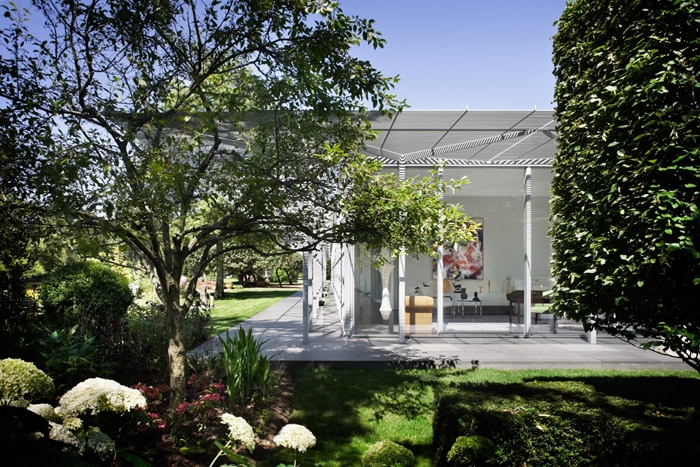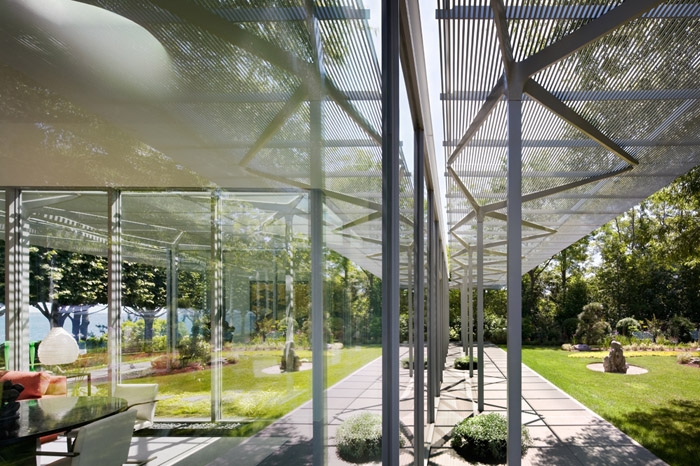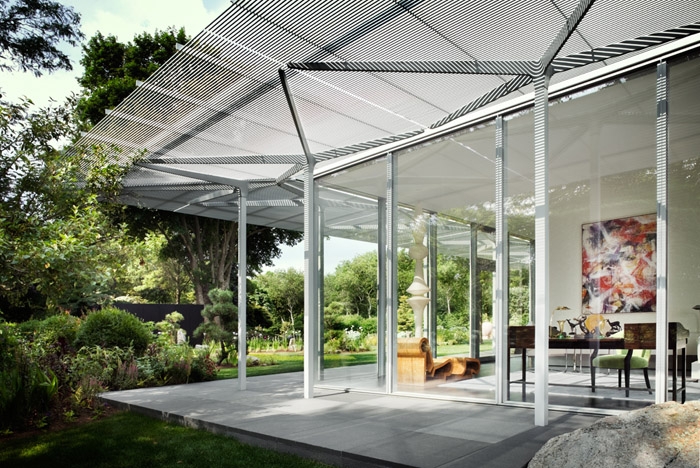










建筑 私人 住宅 白色 玻璃 金属 铝 美国 纽约 Thomas Phifer and Partners
Meandering gardens and woods, sparked with daffodils, peonies and daylilies, flank the straight
drive in. Up ahead near the path’s end is an aperture framed by an arbor of apple trees,
capturing an elemental view of sky and water: the horizon of the Long Island Sound. As you reach
closer range, you suddenly realize you have been looking not merely through foliage, but also
right through the house.
Just behind the copse stands a delicately transparent pavilion. Its light-filtering trellis—a
horizontal tracery of slender aluminum rods extending the roof plane—aligns with the canopy of
trees before it. Woven into the landscape, this is an architecture of subtlety, a precisely grounded
yet quasi-weightless structure, an ethereal rectangle, planted between two existing bosques. Like
feathery fronds, the trellis reaches toward the bordering leafy branches, while the pavilion’s
interior floor plane—fully visible through the glassy, Miesian shell—continues outward, its surface
of ebonized bamboo transformed into an exterior plinth of Indian black granite, a walkway, finely
striated with shadows from the diaphanous, metal canopy above.
Meanwhile, the entry axis penetrates the pavilion’s simple 4,600-square-foot volume, notching
into its far side and emerging as a long, miraculously shallow reflecting pool, incising the lawn with
a silvery film, its distant edge dissolving optically into the Sound.
A perimeter path lines the structure’s transparent shell. Freestanding in parallel alignment, the
interior walls never meet the enclosure. Instead, they form a virtual box within a box, an implied
inner volume. These parallel planes channel long vistas out toward water and garden, only
allowing the seascape’s wide, rugged panorama to emerge in full view at the house’s far side.
More than a one-bedroom retreat for a former museum director and his wife, this is also a place
of extraordinary 20th century paintings, sculptures, and glassware—much of it conveying a sense
of buoyancy or levitation that echoes the pavilion’s lightness. The artwork always figures into view
out, even if only peripherally. Conversely, from the gardens, this colorful indoor collection
projects a presence outdoors.
In the animated interplay between landscape and art, in the shifting ambiguities between inside
and out, the design achieves exceptional balance. An arcing swath of vibrant yellow sedum in the
garden resonates with the golden footbridge in a Chinese screen inside; a mossy rock garden
projects into the pavilion’s simple volume, while the bedroom nestles into a private apse of
garden vegetation. You can look straight through the house without realizing it, but you could
also mistake reflections of trees for glimpses through the pavilion. Morphing with the skies,
flourishing seasonally, the dialogue evolves, nourishing the owner’s desire to live in the garden—
with art.
步入蜿蜒的花园,树林,水仙,牡丹,萱草竞相争艳,到达道路尽头的苹果林,在这里
能领略长岛海峡的水天一色。当你足够接近,你会发现这片矮林里这个精致透明亭。细
长的铝棒水平窗与树林一起过滤光线。构架如此微妙,空灵而轻盈。外侧表皮是一圈玻
璃,地面采用来自印度的花岗岩。
建筑总面积达4600平方英尺,在透明的外框之内,建筑还有一层内框,将观看全景海景
的范围进行了限定,保证了业主的隐私。业主是前博物馆馆长与她的妻子,因此宅子里
有一些非比寻常的现代绘画,雕塑和玻璃器皿。同时花园也非常的精彩,这个项目有着
多姿多彩的室内外元素,建筑师在景观与艺术的互动中,内与外的模糊中,出色的控制
了平衡。实现了主人生活在花园与艺术中的愿望。